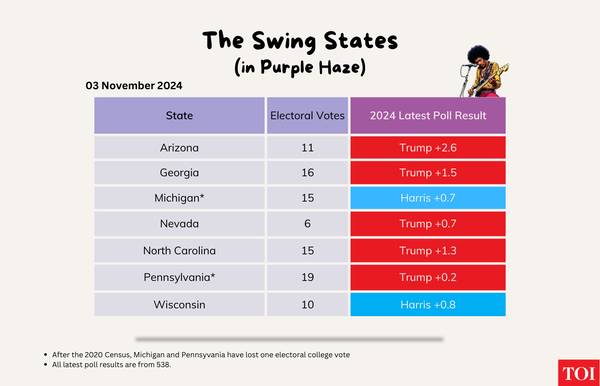
Note: The article was originally published with the title 10 reasons why this is Donald Trump‘s election to lose on November 3. Trump is on course to return to the White House, after a commanding performance in all swing states and breaking down the ‘Blue Wall’.
Nate Cohn, the chief political analyst of The New York Times, recently wrote a piece titled Why Are Democrats Having a Hard Time Beating Trump? He argued, “How is Mr. Trump still so competitive? The simplest answer is that the national political environment just isn’t as conducive to a Democratic victory as many might imagine.” Among the reasons Cohn gave for the Democratic Party’s inability to beat Trump—within the confines of the availability heuristic that exists in American mainstream media—he cites public dissatisfaction with Biden’s leadership, disenchantment with the Democrats on most issues barring democracy and abortion, post-pandemic economic challenges, and the Democrats giving up their own progressive agenda.

No one thought it would be this close two days before election day or predicted Trump’s renaissance. Two years ago, Trump appeared to be a lost cause, on the verge of being disqualified, fighting numerous criminal cases, and even rejected by the Republican establishment, which seemed to have found a new knight in shining armour in Ron DeSantis. The New York Post, which recently endorsed Trump, had buried the news about Trump’s re-election bid deep inside. Now, Trump is powerful enough in the Republican establishment to reject Rupert Murdoch’s VP pick and instead chose JD Vance after being convinced by Elon Musk, David Sacks, and Tucker Carlson.
As of 2 November, Harris led by exactly one point, according to FiveThirtyEight’s poll of polls, meaning nearly half the country is openly admitting that it is backing Donald Trump. So, how did it get so close?
There are, like life, various variables. Here are the top ten:
1) MSM’s Trump Derangement Syndrome

In 2016, when Trump came to power, mainstream American media enjoyed a “Trump Bump,” with readers more engaged with mainstream media, leading to a rise in circulation, subscriptions, and ratings for all mainstream channels. Yet, thundering follows the laws of diminishing returns, and viewers started noticing the dissonance between reality and MSM’s coverage of Trump.
Consider how outlets chose to report claims that Donald Trump had threatened to shoot Liz Cheney. What he did say, in making a point about Cheney being a war hawk, was, “She’s a war hawk, let’s see how she likes war if you give her a rifle and she’s got nine barrels shooting at her. They’re all war hawks when they’re sitting in Washington saying let’s send 10,000 troops to fight the enemy.”
Despite being the subject of two assassination attempts and a disinformation campaign by several agents, including Iran, MSM’s “Trump Derangement Syndrome” has prevented it from covering Trump in a cogent way.
2) Rise of New Media
With MSM failing to cover the whole picture, new media has emerged that asks people to look at Trump on his own merits. This includes X, owned by Trump ally Elon Musk, who has amplified various MAGA talking points. Trump’s podcast appearances on shows like The Joe Rogan Experience and The Flagrant Podcast have also helped dispel labels such as fascist, bigot, and racist that have been thrust upon him.
When Trump speaks, he sounds like a regular human being, and while evil can be banal, the fascist label doesn’t stick for Americans who see him criticised roundly day in and day out in the press. In a world where Joe Rogan has more pull than Jennifer Lopez, Trump’s new media appearances have certainly helped him counter the image curated by mainstream media.
3) Purple Haze in Swing States
The seven swing states are closer than they have ever been and could decide the election. At the time of writing, The New York Times’ average has Trump leading in North Carolina, Nevada, Georgia, and Arizona. Pennsylvania is level, while Harris is just ahead in Wisconsin and Michigan.

A disclaimer often needed for Trump is that many people are hesitant to declare support for him publicly due to fear of backlash, which could mean his actual support is higher than it appears. In 2020, Biden managed to win six of the seven swing states, but it was close. For example, in Arizona, Biden won by just 10,457 votes. A total of 44,000 votes in Georgia, Arizona, and Wisconsin prevented a tie in the Electoral College in 2020, and Trump’s closing of the gap in swing states will be worrying for Democrats.
4) Reality Star
Despite being a legacy bête noire, Trump often outshines his opponents theatrically. He excels at retail politics, often doing things that are extremely relatable. He can also use his opponents’ barbs to shift the narrative. After Harris claimed she worked at McDonald’s, Trump ended up working at an outlet, looking like the employee of the month. After Joe Biden called Trump supporters “garbage,” Trump responded by driving a garbage truck and dancing in an orange garbage worker’s vest. Trump, as Rogan recently noted, often comes across as a relatable non-politician, saying things that resonate with voters.
5) Democratic Disillusionment
As of October 2024, for the first time in three decades, more Americans identify as Republicans instead of Democrats, a remarkable shift given that the Democrats have won the last four popular votes and seven of the last eight. Democrats have become increasingly defensive, relinquishing their earlier positions on immigration, energy, crime, and even social security. Biden’s approval ratings remain low, and Harris has struggled to differentiate her positions from Biden’s. Among various minority groups, including Muslims, Hindus, Latinos, and African Americans, Trump’s popularity has grown, with many feeling Democrats have taken their votes for granted.
6) Sympathy for the Devil
Sympathy for Trump has increased, despite mainstream media’s portrayal. After being de-platformed post-6 January, some individuals who used to see his rants daily forgot how abrasive he could be. Additionally, the Biden administration’s efforts to prosecute Trump in numerous cases have created a sense of sympathy that extends beyond his traditional supporters. Trump has managed to play the card well of a man who is being unduly attacked by the system. In fact, when a former president is treated like this in any other country, there are usually numerous articles by American media outlets about “democracy backsliding”.
7)The MAGAvengers

Unlike 2016, when Trump had surrounded himself with traditional Republicans including VP Mike Pence, Trump’s current team is more MAGA. Many potential Trump voters admit they aren’t just voting for Donald Trump, echoed by Bill Ackman. They are also voting for JD Vance, Vivek Ramaswamy, Tulsi Gabbard, Elon Musk, and RFK Jr. Each of them is a different Jungian archetype who brings something different to the table. They are all, in their own way, exceptionally articulate. RFK packs Kennedy loyalty with huge popularity among vaccine deniers and other conspiracy theorists. JD Vance is an exceptional debater who can dance with the liberal media and make them eat their own words.
Vivek Ramaswamy is a Tiger Mom’s dream child who can articulate the MAGA vision in layman’s terms. Tulsi Gabbard, a former Democrat, is an exceptional debater as well. And Musk is one of the sharpest people alive, who has changed numerous tech industries. Combined, all of them promise a vision of America that is more hopeful than doom and gloom.
Read: Meet the MAGAvengers
8) Musk and X
In the last few months, Musk has gone all-in on Trump, and his achievements, whether at SpaceX or Tesla, are often seen as emblematic of what could become part of the American landscape if Trump returns to office. The mainstream media’s “Trump Derangement Syndrome” seems to extend to Musk as well; it was almost surprising not to see the Biden administration congratulate Musk after one of SpaceX’s most remarkable achievements, when its “chopsticks” caught a booster rocket.

Musk’s acquisition of X (formerly Twitter) has transformed media consumption, with more people preferring X’s unfiltered approach over what they perceive as biased mainstream coverage. Musk’s influence has also helped make it more acceptable for tech figures to support Trump, with some Silicon Valley giants showing their approval openly. In recent weeks, figures like Sundar Pichai, Jeff Bezos, and Mark Zuckerberg have all reached out to the Trump campaign. And with Vance, they might finally have a “tech bro” in the White House.
WATCH: SpaceX catches Starship rocket booster back at the launch pad
9) MAGA’s Kulturkampf Triumph
In the American Kulturkampf, MAGA hasn’t just infiltrated and turned the Republican establishment inside out, but also browbeaten the Democratic Party’s liberal orthodoxy. The Democratic orthodoxy tied itself in knots with a host of issues like the trans movement and identity politics, allowing MAGA to reach historically anti-Republican voters. There is even anecdotal evidence where Indian American immigrants prefer Red states to Blue ones to avoid what they call “trans indoctrination” of children. The same goes for immigration, which MAGA has framed as a battle between illegal immigrants and minorities.
The shifting sand in American politics is evidenced by Harris bragging about her Glock or refusing to say whether prisoners should have access to taxpayer-funded gender-affirming surgery. This shift in identity politics is huge, considering in 2019, she announced her pronouns during a CNN debate. This has also been evident in how men and women are voting. A WaPo average of October national polls shows Harris leading by an average of 11 points among women, while Trump leads by 10 points among men (a 21-point gap in the margin).
10) Doom Loop and DEI

In 2020, Harris’s presidential campaign was an unmitigated disaster, which had to be wrapped up before she could get a single vote. Unlike Hillary Clinton, who had to power through two pugilistic primaries, Harris was virtually given the nomination after the Biden coup. Suddenly, a VP candidate with high unfavorability ratings was projected as one who was the best choice to beat the Republicans. This led many Republicans to call her a DEI candidate.
David Sacks had argued that Harris would get caught in a “doom loop”: the more interviews she gives, the lower her ratings drop, which prompts more interviews. Unlike Trump, Harris struggles at retail politics, and while Trump struggles at the details, his running mate Vance is exceptionally good at that. On the other hand, Tim Walz has failed to bring the same level of enthusiasm to the ticket and was handed a chastening defeat by Vance in the only vice-presidential debate. Of all major party candidates, Harris had the least time to prepare and has struggled as the campaign goes on.
11) America’s racist and misogynist history
And finally, there’s an unsaid truth about American politics, evidenced in the facts. America is a deeply racist and misogynist society. Abraham Lincoln had to go to war to abolish slavery. It wasn’t until 1920 that women could vote in elections. It took until 1965 to extend voting rights to all Black people. State after state used Jim Crow laws in the post-Civil War era to deny Black people their rights. America has voted for a Black man to become president only once. It has never had a female president. And it might be a bridge too far for too many American voters, including Black ones, to vote for a half-Indian, half-Black woman, irrespective of the candidate she is up against. Even in 2024, that might be a bridge too far for America.





